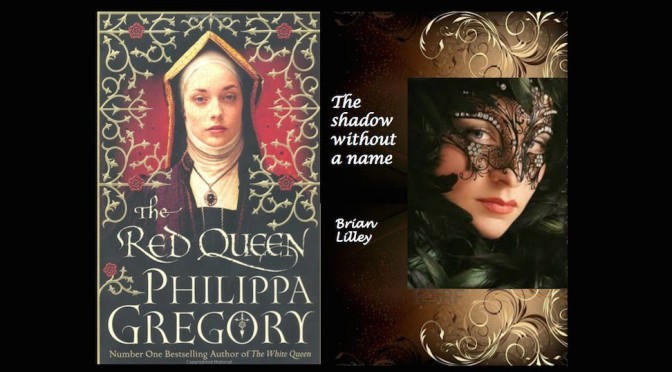As part of the Chisholm course in Professional Writing and Editing, Earl Livings, our tutor set an assignment to identify the competition for our project and make a constructive comparison. I have very much taken the line of asking “What can I learn from a successful, published author.”
“The Red Queen” By Phillipa Gregory
Joan Of Arc
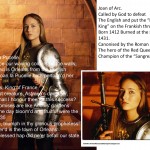 This is the same world explored by Shakespeare ( Henry V, Henry VI pts I, I and III, and Richard III).
This is the same world explored by Shakespeare ( Henry V, Henry VI pts I, I and III, and Richard III).
In 1420 under the leadership of Henry V, the English kings pursued their claim to the French crown with utmost vigour. The French were defeated and had accepted that Henry’s son would be their next king. In 1422 on the death of Henry and Charles. Henry VI became King of both France and England. By 1429 there were only isolated pockets of French resistance.
In 1424 a 12 year old girl claimed to have visions which told her that the English King did not have ” the right to rule”
In 1428 the French pretender, Charles VII appointed Joan as commander of his army. She managed to turn the war around and succeed in getting Charles crowned as king. Nevertheless she was captured by the English, tried for heresy and burned at the stake. In the book Joan is an inspiration to Margaret Beaufort to accept non but God’s chosen one as King of England. Conveniently this was her son.
The Princes in the tower
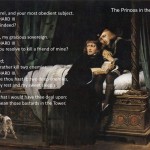 The Princes in the tower were the sons of Edward IV, Edward V and his younger brother Richard. This murder mystery was document by Sir Thomas More and also by Shakespeare. They both put the blame on Richard III But there are many other suspects, including Thomas Stanley, the third husband Of Margaret Beaufort. In the book Margaret herself gives the order for the Princes to be murdered but the men sent to perform the deed are unsuccessful.
The Princes in the tower were the sons of Edward IV, Edward V and his younger brother Richard. This murder mystery was document by Sir Thomas More and also by Shakespeare. They both put the blame on Richard III But there are many other suspects, including Thomas Stanley, the third husband Of Margaret Beaufort. In the book Margaret herself gives the order for the Princes to be murdered but the men sent to perform the deed are unsuccessful.
The Battle of Bosworth Field
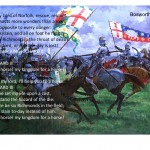 Is this Shakespear’s most famous line? Probably not but it widely quoted. Shakespeare denigrated Richard III deliberately. In his historical plays he worked as an apologist for the Tudors helping justify their claim to the throne. At the end he makes it appear that Henry Tudor himself (Richmond ) kills Richard III whereas he was probably killed by Thomas Stanley’s soldiers. It must be remembered that some academics believe that there is evidence that Thomas Stanley’s G4 Grandson William Stanley, wrote at least some of Shakespeare’s plays!
Is this Shakespear’s most famous line? Probably not but it widely quoted. Shakespeare denigrated Richard III deliberately. In his historical plays he worked as an apologist for the Tudors helping justify their claim to the throne. At the end he makes it appear that Henry Tudor himself (Richmond ) kills Richard III whereas he was probably killed by Thomas Stanley’s soldiers. It must be remembered that some academics believe that there is evidence that Thomas Stanley’s G4 Grandson William Stanley, wrote at least some of Shakespeare’s plays!
The Author of the Red Queen- Phillipa Gregory
(http://www.philippagregory.com/living-room/about)
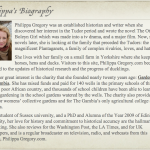 Phillipa Gregory’s was first published in 1987 in the Wideacre series.
Phillipa Gregory’s was first published in 1987 in the Wideacre series.
During the writing of the series she divorced two husbands. She then wrote some non series novels in the 1990’s before hitting the jackpot with “The Other Bolyen Girl” . This book was serialised on British television and then purchased by Hollywood.
It was a story which had previously been overlooked by the media and her telling of the story in the first person from a woman’s perspecptive, aroused interest.
It was the key to the publishing of many books in quick succession, many of which may have been written before the Bolyen Girl
The Film
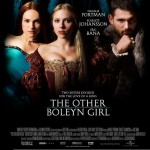
The film was critisised by some for abandoning the POV of Mary Bolyen, which Phillipa Gregory had selected for the book and which to a certain extent made the book unique.
Story Structure
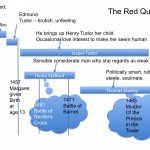
The premise of “The Red Queen” is that genealogy determines the “ right to rule”.
Background
(not directly reference in the book)
This concept was first reliably recorded in 987. When the French Carolingian Dynasty failed to produce a direct heir a committee of bishops and Lords chose Hugh Capet as the next king. He was not the closest in normally accepted rules of succession but he was chosen because of his “Nobility” after an examination of his bloodlines.
In 1328 when the Capet Dynasty failed, a similar process chose Philip de Valois as the next King. Again he was not the closest in normally accepted rules of succession (Edward III of England was), but he was part of the bloodline. In 1399 Henry IV of Lancaster used the bloodline argument to overthrow and murder his cousin Richard II. In the meantime the Edmund of York had acquired an exotic bloodline of his own by marrying one of the Pedilla sisters from Castile. Now the House of York believed they had in fact a superior blood line to that of the Lancasters and therefore the right to rule. War was inevitable. It lasted 90 years.
Story line
The story line of the Red Queen is however not about bloodlines or battles. It is a story of one woman’s suffering at the hands of men who are either brutal and unfeeling or considerate but weak. The first 100 pages could have been about almost be any woman married to unsatisfactory men, set anywhere in any time period. Two marriages which leave her cold; a pregnancy at twelve. All she has to live for is the love of her child and an obsession that she or he has the right to rule. In pursuing this objective she sinks from a child with saintly aspirations to a ruthless murderess and yet still sees herself as blessed by God. It is an interesting and somewhat chilling progression. The bloody background of the Wars of the Roses is secondary to her own feelings.
Style
Style is prosaic, lacking poetic beauty, common place and unromantic. Exposition of people and places is given rarely and grudgingly. One can almost hear the editor saying “but you have got to give some feel for the world she lives in, its tone and atmosphere”
The story is not about places or great events, it is about what goes on inside this woman’s head. This is where the fiction is. Her opinions about four men and her feeling, or lack of feeling, for them
Edmund Tudor is brutal, crude, unfeeling.
Henry is soft and cowardly,
She would rather he fight for her cause than be sensible and considerate.
Thomas Stanley is devious, ruthless, politically smart but sterile.
In this final loveless relationship there is not a criticsm ever crosses her mind, except perhaps that things happen too slowly for her.
She endures a life without pleasure or satisfaction endlessly working to reach what she believes is her god given right to rule England
The Sangreal
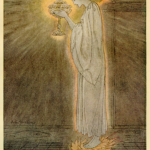
It is never mentioned as such, but the book is dominated by Margaret’s belief, underpinned by what Joan of Arc achieved that some people have the right to rule and are ordained by God to do so.
Incidentally for someone who has such faith in God’s will there is not a single mention of her ever going to church.
In Margaret’s mind it is the descendants of Henry IV and in particular her own family the Beauforts who have the right to rule in England
She sees herself as Queen of England and another recurring fantasy is signing herself as Margaret R., Margaret Regina. She sees it as her destiny. There is no attempt to justify this belief and it works because we are inside her head as a very young girl when it seems quite acceptable for her to have unreasonable expectations.
As she grows older and becomes obsessed with bringing her son the throne again it seems perfectly credible that such an unreasonable person would retain unreasonable expectations and never question the justification. The end justifies the means.
When she hears that Richard is dead and her son the king:-
“I meet the eyes of Christ the Lord and I all but wink at him. “Thanks be to god” I say as if to nod to a fellow plotter.”
POV
The book is slavishly first person. Indeed in the first act it becomes tiresome as we learn about her father, another dreadful man and Joan of Arc, a wonderful woman, through conversation.
Then suddenly as Henry, her second husband rides out to fight in the battle of Neville’s Cross we switch into third party omniscient. It is such a shock that I had to stop reading and go back to see if I had missed the start of a long monologue. No! and it isn’t exclusively her husband’s viewpoint either.
Simply it was necessary to describe the battle. First Person through the eyes of Margaret could not achieve that.
For the battle of Barnet a different device is used she actually goes to the battleground to rescue her husband or bury his body
However for the final battle. Again it is necessary to move to third part to show the action.
“The shadow without a name” by Brian Lilley
The third book in ” The sword and the chalice” Saga
Story Structure
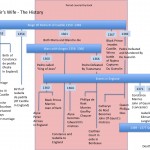 The premise of “The Shadow Without A Name”is also that geneology determines the “ right to rule”. The concept that Holy blood lines originate with Jesus (or even further back ) was raised in Great Britain in a TV documentary in the Chronicles series, screened in 1980. In 1982 the book Holy blood – Holy Grail by Henry Lincoln, Micheal Baigent and Richard Leigh was published as a follow up to the TV series. In 2002 Laurence Gardner provided sets of geneological trees which purported to support the premise of the earlier book.
The premise of “The Shadow Without A Name”is also that geneology determines the “ right to rule”. The concept that Holy blood lines originate with Jesus (or even further back ) was raised in Great Britain in a TV documentary in the Chronicles series, screened in 1980. In 1982 the book Holy blood – Holy Grail by Henry Lincoln, Micheal Baigent and Richard Leigh was published as a follow up to the TV series. In 2002 Laurence Gardner provided sets of geneological trees which purported to support the premise of the earlier book.
It was content of these books which Dan Brown used in 2003 as a major component of the plot of The DaVinci Code. Henry Lincoln sued Dan Brown for breach of copyright and in a major case in the high court of England a ruling was handed down ‘it is impossible to hold a copyright on historical fact’
Temporal fit
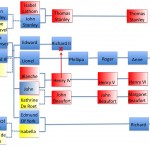 I could hardly believe it when I went looking for a competitor to my own book{s) as one of the assighnments given to us by Earl Livings and found this book prominently displayed. “The Red Queen” deals with the execution of the Wars of the Roses and their conclusion. “The Shadow without a name” deals with the underlying causes, from a point of view of continuity, they fit together very well.
I could hardly believe it when I went looking for a competitor to my own book{s) as one of the assighnments given to us by Earl Livings and found this book prominently displayed. “The Red Queen” deals with the execution of the Wars of the Roses and their conclusion. “The Shadow without a name” deals with the underlying causes, from a point of view of continuity, they fit together very well.
Margaret Beaufort is the great grandaughter of Catherine de Roet, a character in “the Shadow”. Thomas Stanley is the great grandson of John Stanley another character in my book. Initially I thought the four southern women introduced into english society in the middle of the 14th century had a mentor, which is why I invented Ximene. I now believe there was a far more substantial reason for them to become mistresses and wives to the royal family, their bloodlines!
Perhaps Phillipa avoided the detail of this to avoid comparions with Dan Brown, I have sympathy with this viwpoint. It was initially my own reaction. I did not want to do what had already been done! But now I don’t think I can avoid it. Dan Brown and the others writing about the Sangreal have never identified that wars were fought over this. It doest not matter wether we believe in it they did and were prepared to die for that belief.
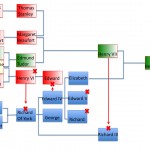 The Red Queen avoids revealing the source of Margaret’s belief in her “right to rule” or why the Yorkist faction had similar but contrasting beliefs. “The Shadow” does not.
The Red Queen avoids revealing the source of Margaret’s belief in her “right to rule” or why the Yorkist faction had similar but contrasting beliefs. “The Shadow” does not.
The shadow commences with Ximene Improbably rich and improbably well connected with the English royal family. The first two books in the series explain how that came about. Ximene uses her wealth in trading ventures which generate more wealth. Her aim is to fund the establishment of a haven for Cathars, a faith which is being persecuted to the point of extinction.
Her trading routes are under threat in the east because of Ottoman expansion and in Southern Spain because of the civil war(Pedro of Castile against Henry Trastamara his illegitimate brother)
The story use the occasion of a conference in Seville to make Ximene aware of Maria Padilla’s bloodline and Ximene’s decision to save Maria’s daughters by taking them to England.
Style
In 2008, before I started the professional writing course at Chisholm, I sat in a pub at the top of Golden Hill in Shaftsbury Dorset. A scantily clad lady who told me she was the local french teacher had just spent half an hour describing what fun it was being trapped in the town in the winter snowstorms and how “sociable” everybody was.
I decided it was a suitable sequence for one of my books but i did not know where it fitted. I detached myself from the french teacher and sat down to write:-
“The week after Chrismas 1357 it snowed heavily. Ximene, the Eagle, in her persona as Diana, Countess of Shaftsbury was isolated from the rest of the world in her eyrie on the top of Shaftsbury Hill. By a happy chance Joan of Kent and the Black Prince were visiting, with other courtiers when the snow fell. They had made the short journey from King’s Court at Gillingham, the home of the Prince’s mother Queen Phillipa. The main purpose of the visit was to agree a common strategy of how to convey the news to the King that Ximene would not marry the Prince. The snow prevented them leaving. Ximene’s home was therefore a centre of music, dancing and festivity for several days.”
Eventually this scene was resurrected as part of the current project. however it now reads:-
“The first snowflake drifted slowly past the window. Ximene watched in fascination as in the gentlest breeze it hesitated, hovered and danced in suspended animation before her eyes, before falling once again. She willed it to repeat the performance but it didn’t. It was replaced by several other snowflakes each one larger than the last until, after no more than five minutes, it was snowing heavily. The characteristic silence, which always accompanied snow, fell on Langdon House. Ximene gently pressed her fingers against the window. The glass was cold to her touch and contrasted with the rough warmth of the lead, which provided the structural support for the exquisite diamond shaped panes of glass. It was like touching ice an illusion compounded by the condensation now coating the inside of the glass. Like melting ice!
She smiled with satisfaction. Three years work was now complete and the former monastery dormitory was now her home, and ready to receive visitors. Tonight it hummed with activity and she savoured the intermingling smells of sweetbread and roast pig and fresh bread permeating the entire building. She rubbed the central areas of the window and gazed out at the ever-thickening snow. Not only did this glass keep out winter winds and let in light but a central diamond of a dozen panes had been cast, ground and polished, so that it was possible to see outside. Ximene chuckled, she had no idea what the central panes would have cost, but what was the point of trading with Venice if no advantage was taken of the miracles of Murano?”
This is third party viewpoint and very descriptive. This will soon be workshopped but despite Phillip’s success with a prosaic style and first person view point I don’t think I will be abandoning my developing style!
Conclusions
Both Phillipa Gregory and Alison Wier ( slightly different gendre) are concentrating on women. I also write about a woman .
However my men also have a journey.
First person gives readers strong identification with the characters they read about.
It is extremely possible in this way to feel sympathy for inherently unsympathetic characters.
First Person POV does not work well in complicated action scenes.
Fist person POV does not work well where there are separate threads involving different people. ( we know virtually nothing about Jasper in the Red Queen)
Even totally unannounced changes in point of view can be made to work .
Prosaic stile can work well and be maintained through a whole book but more elaborate styles are also acceptable.
